

“Portraits of the Passion:
Prayer and Arrest in Gethsemane”
Matthew 26:31-56
Pastor Kevin Vogts
Trinity Lutheran Church
Paola, Kansas
Ash Wednesday—February 26, 2020
Grace to you and peace from God our Father and the Lord
Jesus Christ. Amen.
Years ago when I lived in Lawrence, I had some time to wait on the University of Kansas campus, and wandered into the Spencer Museum of Art. I was very pleasantly surprised to discover they have a spectacular collection of the highest quality Christian art, from the early church, Middle Ages, Renaissance, and Reformation eras. It is really one of the hidden gems in the state of Kansas. The Nelson-Atkins Museum in Kansas City also has a fine collection of classical Christian artworks. The theme for our Wednesday evening Lent services this year is “Portraits of the Passion,” the Lenten story illustrated by artworks from these museums. We begin this evening with Christ’s “Prayer and Arrest in Gethsemane.”
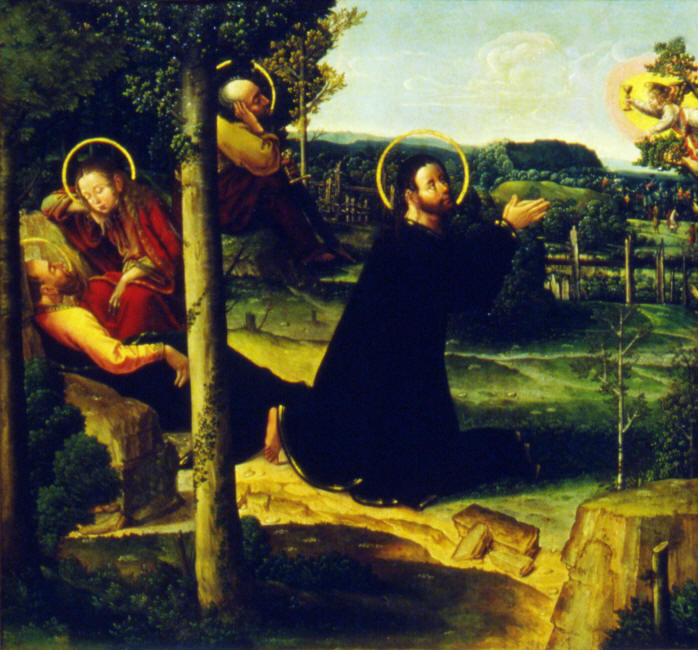
“The Agony in the Garden”
Anton Woensam von Worms – Before 1530 – Oil on Wood
The Gospels tell us that following the Last Supper on Maundy Thursday, Jesus and his disciples walked from Jerusalem out to the Mount of Olives. When I’ve visited the Holy Land I’ve walked that route myself a time or two, and it’s about a half-hour hard climb, down through the steep Kidron Valley and up the Mount of Olives.
“They went to a place called Gethsemane, and Jesus said to his
disciples, ‘Sit here while I pray.’” It was called the Mount of Olives
because in ancient times olive groves covered its slopes. The word “gethsemane”
means “oil press,” so it seems the Garden of Gethsemane included a press to
squeeze the oil from the olives. As a matter of fact, archaeologists think
they have found in a cave remnants of the very olive oil press after which
Gethsemane was named. But, that night in the Garden of Gethsemane, it was not
olives but our Lord himself who was pressed, excruciatingly, as the sins of the
whole world weighed down upon him.
“He took Peter and the two sons of Zebedee along with him, and he began
to be sorrowful and troubled. Then he said to them, ‘My soul is overwhelmed with
sorrow to the point of death. Stay here and keep watch with me.’ Going a little
farther, he fell with his face to the ground and prayed, ‘My Father, if it be
possible, let this cup pass from me. Yet not as I will, but as you will.’”
The agony of Christ praying in the Garden is one of the most popular
themes in medieval and renaissance art, as in this German painting from the
early 1500’s. While Peter, James and John are asleep, Christ “prayed so
earnestly that his sweat became like drops of blood falling to the ground.”
What did Jesus mean when he said, “My Father, if it be possible, let
this cup pass from me”? Imagine drinking from a cup of deadly acid which
you know will sear your throat and kill you. The “cup” Jesus speaks of was
far more terrifying than that. The “cup” Jesus speaks of was symbolic of
the torture he was about to endure. The physical torture, flogged, beaten,
crucified; and especially the spiritual torture, the sinless Son of God taking
upon himself the sins of the world, suffering on the cross the damnation we
deserve. As Peter says, “He himself bore our sins in his body on the
cross.” When Jesus prays, “My Father, if it be possible, let this cup pass
from me,” he is saying, “If it is possible to redeem the world without me
drinking this horrible cup of death and wrath and damnation, then relieve me of
this cup.”
It is interesting that in all these paintings an angel is portrayed as
bringing this symbolic “cup” of suffering and death down to Jesus. Not the
devil, but an angel.
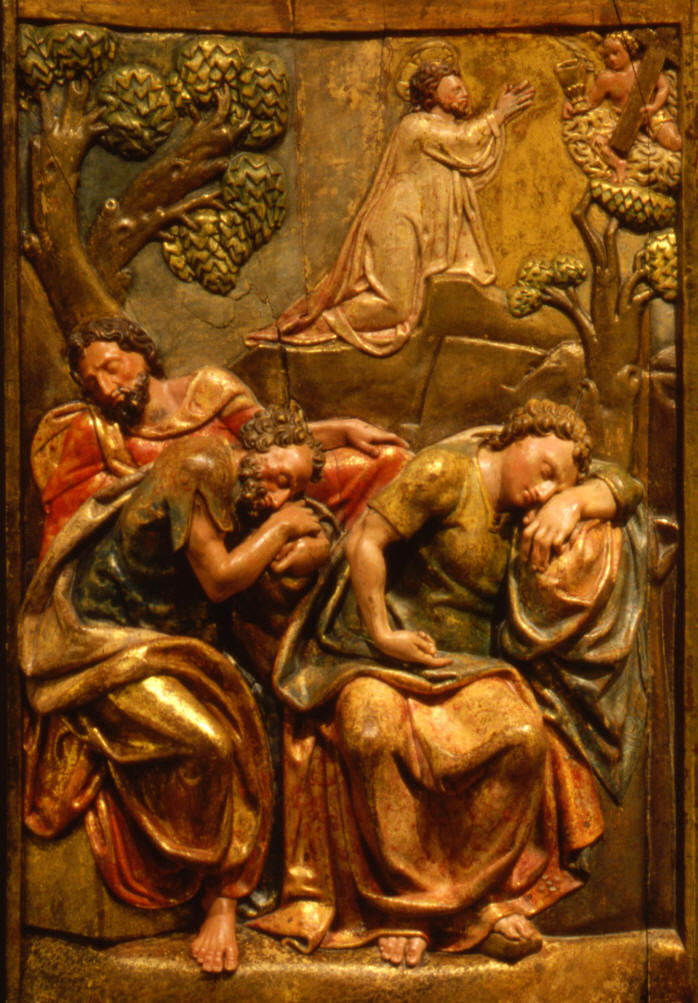
“Christ in the Garden of
Gethsemane”
In this Spanish painted wood carving from the late 1500’s, an angel is
bringing to Jesus both the cup of suffering and the cross itself. This
symbolically portrays what Isaiah says, “It was the Lord’s will to crush him and
cause him to suffer.” It is an angel of the Lord bringing the cup of
suffering and the cross to Jesus because his crucifixion, death and resurrection
was not a mistake, or a plot of the devil, but “the Lord’s will,” God’s eternal
plan for the salvation of the world. For there was no other way to save us
from our sins except for God’s own Son to give himself as an atoning sacrifice.
Jesus willingly sacrificed himself for you. “I am the Good
Shepherd,” he says, “. . . and I lay down my life for the sheep. . . No
one takes it from me, but I lay it down of my own accord.” John says, “The
blood of Jesus, his Son, cleanses us from every sin.” That is what Jesus
did for you, by his suffering, by his death on the cross, by his resurrection.
On account of his sacrifice, you are forgiven, you are cleansed in God’s sight
of every sin.
Another major theme of these artworks is Jesus’ disciples falling
asleep during his agony in the Garden, which Jesus himself interprets for us:
“He returned to his disciples and found them sleeping. ‘Could you not keep watch
with me for one hour?’ he asked Peter. ‘Watch and pray so that you will
not fall into temptation. The spirit is willing, but the flesh is weak.’”
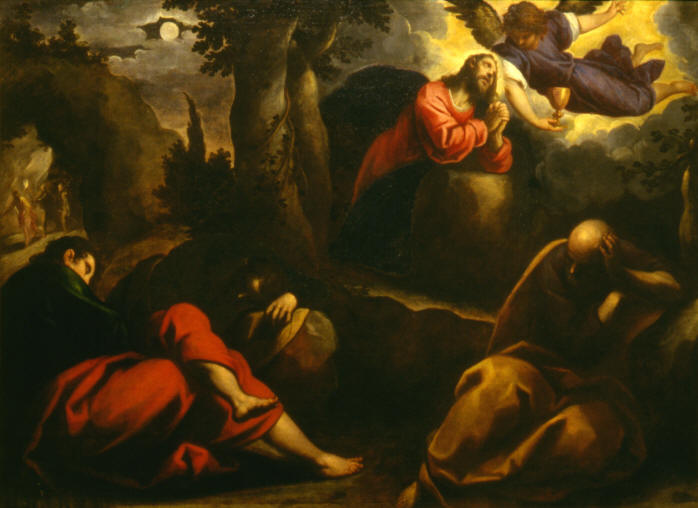
“Christ in Gethsemane”
Martin Luther says: “How does Christ himself pray in the Garden of
Gethsemane? This is a practical and indispensable example which we ought
to follow gladly and not forget. Our Lord Jesus Christ adds these words to
his prayer: ‘Yet not my will but yours be done.’ You should do likewise.
If you are in tribulation and suffering, turn to God as a child turns to his
father, cry to him for help and say: ‘O heavenly Father, see what things are
happening to me! For the sake of your dear Son Jesus Christ help me!’
But since God alone knows what is good and useful for us, we should place his
will first and our will second.”
The background of this Italian painting from the 1600’s anticipates the
next scene in the Passion story, a group of soldiers coming to arrest Christ in
the Garden. “Then he returned to the disciples and said to them, ‘Are you
still sleeping and resting? Behold, the hour is at hand, and the Son of Man is
being betrayed into the hands of sinners. Rise, let us go! Here comes my
betrayer!’ While he was still speaking, Judas, one of the Twelve, arrived.
. . guiding a detachment of soldiers and officers from the chief priests
and Pharisees, and they came there with torches, lanterns and weapons.”
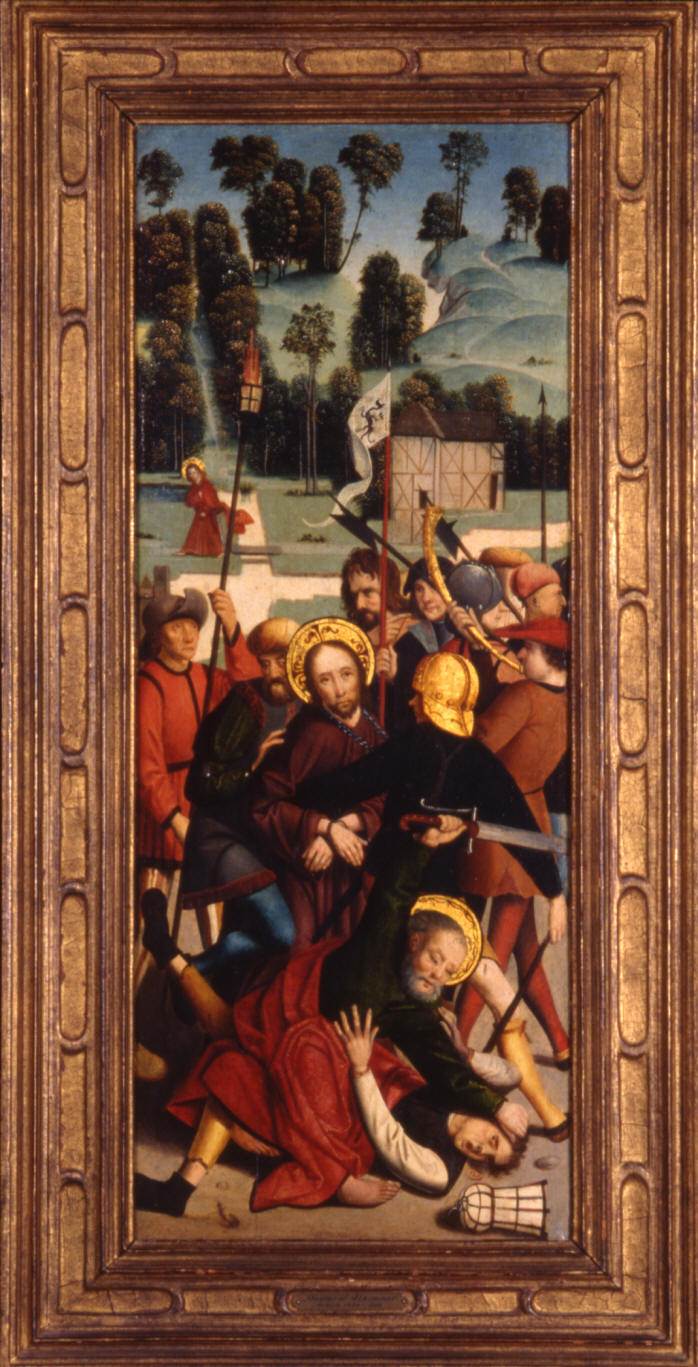
“The Betrayal of Christ”
The paintings of Christ’s arrest, like this one from the 1500’s,
feature an impulsive act by Simon Peter: “Then Simon Peter, who had a sword,
drew it and struck the high priest’s servant, cutting off his right ear.
The servant’s name was Malchus. Then Jesus commanded Peter, ‘Put your
sword back in its scabbard! Shall I not drink the cup the Father has given me?’
. . . And he touched the man’s ear and healed him.” The disciples
mistakenly thought that Jesus was going to establish an earthly kingdom, if
necessary by force. But, as Jesus told Pontius Pilate, his kingdom is not
of this world. It is a spiritual kingdom, established in the hearts of
believers, not by earthly force but through the power of his Word and
Sacraments.
In this painting the sword is still in Peter’s hand, and Malchus’
severed ear lies graphically on the ground. As was common in medieval and
renaissance art the soldiers are whimsically portrayed with weapons, lanterns
and uniforms that reflect the era of the painting, rather than of the Bible.
Watching in the background is the Apostle John. He and Peter followed at a
distance to Jesus’ trial.
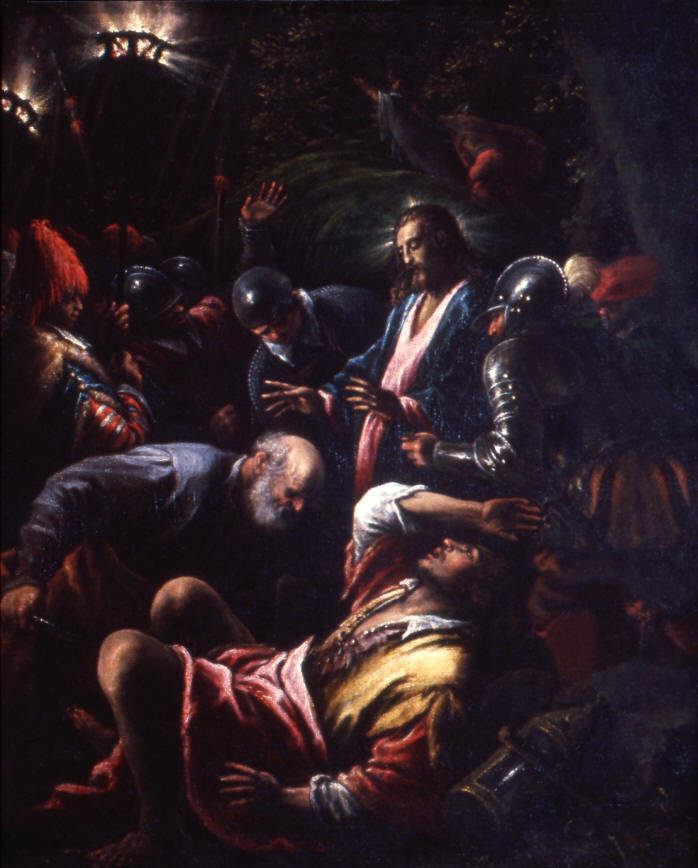
“The Healing of Malchus’ Ear”
This painting from later in the 1500’s portrays the moment when Malchus’
ear was healed by Christ. The unusual dark mood of this painting
beautifully illustrates Jesus’ words to them in the Garden of Gethsemane:
“Then Jesus said to the chief priests, the officers of the temple guard, and the
elders, who had come for him, ‘Am I leading a rebellion, that you have come with
swords and clubs? Every day I was with you in the temple courts, and you
did not lay a hand on me. But this is your hour—when darkness reigns.’
Then seizing him, they led him away.”
Return to Top | Return to Sermons | Home | Email Church Office